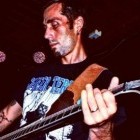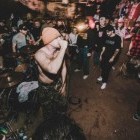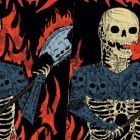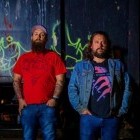
“Never trust a ‘hardcore’ kid that's never listened to Punk Rock.” – Roger Miret
Old heads from New York love bringing up 1977 to younger people as a flex. The mere mention of that infamous year lets you know that they’re automatically cooler than you because they were there for the height of the downtown punk rock scene and the early days of hip-hop.
They also make sure to let you know that 1977 was the worst of the bad old days in New York City. There’s a whole cottage industry of documentaries and films focused on how grimy and cool 1977 was (Summer of Sam; The Bronx is Burning, NY77: The Coolest Year in Hell). I don’t remember it. I was one year old.
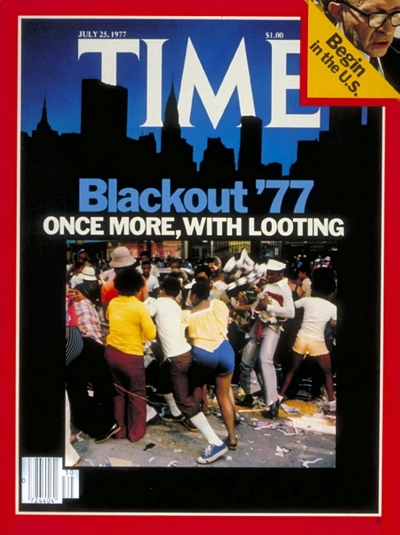
If you ask me, the early ’90s were by far the most dangerous time in New York history. The city was crushed by the AIDS and crack epidemics. Racial tensions were out of control in the years after the Howard Beach and Yusef Hawkins murders. Riots raged in Crown Heights.
The city set a record in 1990 with 2,262 murders (compared with 391 in 2023) and 100,280 robberies (100,275 if you don’t count the ones that happened to me—that number dropped to 16,910 by 2023). Despite what FOX News and the conservative media are trying to sell you, NYC is 80-something percent safer now than it was in the early ’90s.
Back then, things especially sucked for us hardcore kids because CBGB stopped putting on hardcore shows. The club pulled the plug on their infamous Sunday Matinees due to shows getting too violent and out of control. Worse yet, most of the great bands of the first and second waves of NYHC were either broken up, semi-active, changed their sound drastically, or “went in a new direction” in grown-up post-hardcore bands.
Once CBGB was no longer the centralized gathering point in Manhattan for tri-state area hardcore kids, skinheads, and punks, ABC No Rio on the Lower East Side tried to fill the gap. They put on hardcore punk matinees in the early ’90s with bands like Rorschach, Yuppicide, Born Against, and Citizens Arrest.
READ MORE: Classic ABC No Rio Flyers From Artist Jon Reed
In an attempt to right some of the wrongs that happened at the CB’s matinees, ABC No Rio operated as an inclusive space—for punks, by punks—that didn’t allow racists, sexists, homophobes, or fighting. None of this appealed to the meathead Brooklyn hardcore kids who essentially took credit for getting shows at CBGB shut down. To them, ABC was “herb shit”—too punk, too hippy, and too artsy.
Brooklyn kids, rejecting the Manhattan-ness of it all, created our own completely insular hardcore scene in the deep South of the boro. It was the opposite of what they were trying to do at ABC No Rio: Fighting and antisocial behavior seemed to be the whole point of hanging out at shows at the Crazy Country Club in Brooklyn’s Chinatown and L’Amour in Bay Ridge. This, perhaps not coincidentally, is around the time that the word “punk” fell off the “hardcore punk” moniker.
The early ’90s Brooklyn scene was devoid of any punk influence in sound or ethos. L’Amour, for example, was a big rock club where bands played on the same stage that Guns N’ Roses and Metallica played a few years earlier. No liberty spikes and bondage pants here—the hardcore kids dressed like hip hop plumbers in oversized Carhartt jeans and hoodies.
There wasn’t a woman in sight. Videos from back then looked like somebody snuck a camera into the yard at Spofford Juvenile Detention Center. Shows at the Crazy Country Club were even wilder due to the younger crowd and absence of security. It looked like a talent show on the Lord of the Flies island.
Our local bands of that time were Biohazard, Merauder, Confusion, Darkside, and Life of Agony. There was nothing cornier than being a metalhead in the early ’90s, yet they played an aggressive style of streetwise metal that traded face-melting guitar solos for relentless mosh parts. Suddenly, an entire generation of Brooklyn kids went to one show at CCC, cut their hair, turned their backs on metal, and became hardcore kids overnight.
To us, hardcore sounded more like Obituary and Slayer than Minor Threat. As for the positivity preached by ’80s Youth Crew bands like Youth of Today and Gorilla Biscuits? Well, Life of Agony sang about suicide. Merauder reminded us that “Life is Pain." Biohazard told hard-boiled street stories over hip-hop beats and thrash riffs.
Nobody on stage was encouraging kids to be “physically strong, morally straight, positive youth” in South Brooklyn. The crowd violence at these shows was as brutal as the breakdowns and we loved every minute of it. To teenage kids like us, these hardcore shows threaded the line between adrenaline and fear—kind of like crossing the street and almost getting hit by a car.
Seeing kids getting swung on in the pit by some dude with a hammer was scary, but not enough to scare us away. We’d all be back the next week for more because we wanted to be a part of it.

It wasn’t all knucklehead bullshit. Witnessing the birth of first-wave deathcore with Confusion and Darkside was exciting and inspiring. Nobody sounded like them…until, ten years later, every band on Jamey Jasta’s Headbanger’s Ball sounded like them. Confusion were Brooklyn’s Most Brutal. No band went harder. They should have been the biggest extreme metal band in the world, but there they were playing their hearts out for us mooks.
In 1994, Justin Brannan (Indecision, Most Precious Blood, NY City Council) and I started X-Treme Zine to promote the Brooklyn hardcore bands we felt were massively underrated and overlooked once you crossed the border of our boro. We really wanted to tell people that Brooklyn hardcore wasn’t just the domain of Neanderthals.
Some people starting bands at the time were super passionate, thoughtful, and socially conscious. The genre was evolving. It self-selected against some of the things we saw—namely, thugs who didn’t care about music going to shows, smoking dust, and fighting teenagers. Sure, that still happened, but it wasn’t the only thing that happened.
This was the golden era of hardcore I came up in—the negative ’90s. I always knew I wanted to write about it. It took me 30 years to do it, and it’s where I set my novel, Brooklyn Hardcore. I wanted to write a noir crime thriller in the absurd world of hardcore crews AKA music gangs. Nobody else wrote about the people I knew and the kind of world we grew up in.
Getting it right meant removing all my inherent sentimentality and nostalgia. In truth, I was writing about the end of an era. The forgotten years of NYHC. The end of the century-long run at the top for the Mafia. The last days of NYC as a working-class city. Brooklyn was my main character, and they underwent a lot of changes over the last three decades.

If I was going to do my version of unflinching social commentary, I had to be real. A lot of people have become revisionist historians on Facebook. People I’ve known my whole life claim a different backstory. Bad Brains was their band growing up (despite the fact that I never heard them play a single Bad Brains song), though I knew that, like me, they missed HR’s version of the band.
We saw the Israel version of Bad Brains on the underrated Rise tour. Back then, in real life, we listened to the 25 ta Life demo, Pantera, Helmet, the East Coast Assault comp, and every single one of us agreed that Body Count/DRI/Exodus at L’Amour was both the best and the most insane show we’ve ever been to.
This forgotten era of Brooklyn Hardcore ended abruptly on the night 18-year-old Christopher Mitchell died in a stagediving incident on December 18, 1994, at a Life of Agony/Shelter/Lament show. I was outside the show that night, but I didn’t come in. I remember telling Jon from Lament that I wasn’t going inside because, “my girlfriend’s parents are out of town tonight but L’Amour will be here forever.” That was the last show at L’Amour. (It reopened as a different place years later.)

As 1995 rolled around, the Brooklyn bands continued to grow and change. Indecision and Shutdown spearheaded the Youth Crew ’95-era of positivity, and Inhuman reintroduced the punk to hardcore punk. They weren’t just local bands anymore. They weren’t even just New York bands anymore. They spread Brooklyn Hardcore to the world.
***
If you want to check out Eddie's book, Brooklyn Hardcore, it’s available at NYHC Comics, Generation Records, Tiny Raccoon Books, Village Works, and The Bookmark Shoppe.
You can also get it from Amazon or directly from Eddie on Etsy. If you buy one from him, he’ll sign it and send you a free BKHC lapel pin.

Tagged: biohazard, confusion, darkside nyc, indecision, life of agony, merauder


